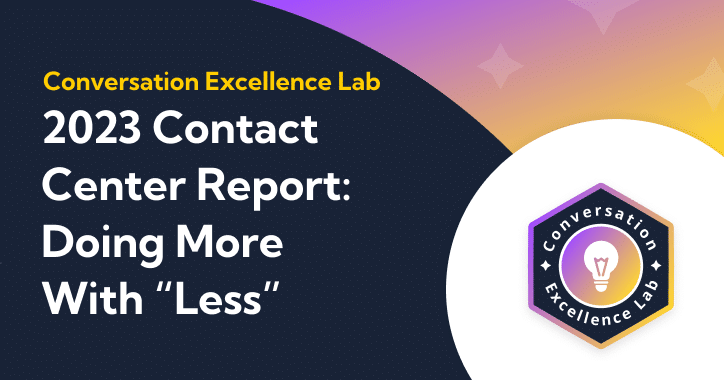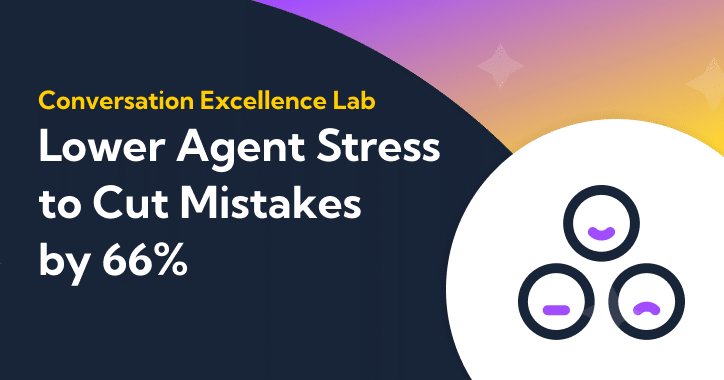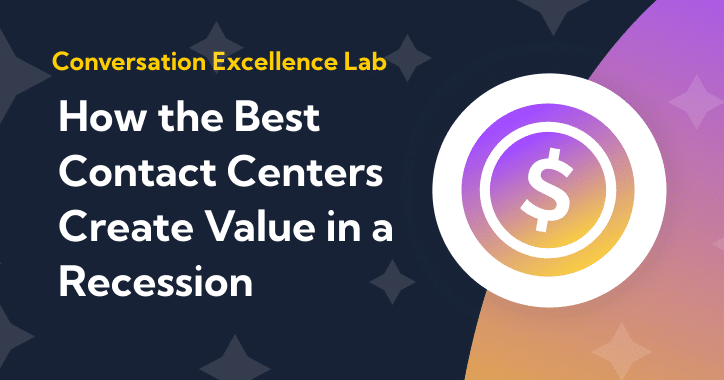“Where do you see yourself in 5 years?” is a question we’ve all been asked, and asked ourselves, from time to time. For better or worse, it’s a useful question to help understand a person’s expectations and motivations in their role and in their life.
For this reason, we asked over 2,000 contact center workers what they thought their future holds. Respondents could choose between six options:
- In my current role at another contact center
- In my current role at my current company
- In a more senior role at my current company
- In a more senior role at another contact center
- In another industry & job altogether
- Retired
Key Takeaways
- Whether a worker is hourly or salaried strongly correlates with whether they want to stay at their current job or not.
- Workers who are most satisfied with their pay are most likely to see themselves in their current role in 5 years. The least satisfied see themselves in a different industry altogether.
- A worker’s industry can help predict their 5-year plan. The same can be said for a worker’s current job function.
- The more formal education a worker has earned, the more likely they are to see themselves growing in their current company.
These findings are part of our series on agent attrition in today’s contact centers. Check out our full report here.
Subscribe to future Conversation Excellence Lab reports below:
Hourly Workers Are More Likely to Switch Companies
Between hourly and salaried workers, we found that hourly workers are most likely to see themselves in a more senior role with their current company.
However, they’re also more likely to move companies in the next 5 years. 26% of hourly workers plan on leaving the industry altogether, while only 11% of salaried workers said the same.
Salaried workers are much more likely to stay put. 30% of salaried respondents see themselves in their current role (compared to 19% of salaried workers) while 34% saw themselves in a more senior role in their current company.
Figure 1: Five-Year Outlook by Hourly vs. Salaried Employees
Overall, this suggests that whether someone is hourly or salaried is correlated with whether or not they want to stay at their current job or with their current employer in 5 years time. This is supported by our findings in our report on agent retention, where we showed that hourly workers are highly motivated by their pay, while salaried workers are also likely to consider other factors before leaving a job.
These differences are generally consistent with prevailing thoughts on hourly rates vs salaries. Workers with salaries, since they have a consistent paycheck, can weigh out other benefits their current employer may offer or what they could gain from another. Hourly workers, by comparison, are vulnerable to inconsistent paychecks.
Additionally, if we separate respondents into front-line and leadership roles, salaried employees are more likely to be in the latter category. We can assume individuals in a leadership role are more likely to have an established career in a contact center, at least compared to front-line roles, which may make them less likely to see themselves at a different company or in a different industry altogether.
All Workers Follow the Money
In a previous report, we showed a worker’s pay rate overwhelmingly influences whether they would leave their current position or not.
Similarly, workers who are most satisfied with their pay are most likely to see themselves in their current roles in 5 years. On a scale of 1 (least satisfied) through 7 (most satisfied), those least satisfied are the most likely to see themselves in a different industry or job altogether.
Figure 2: Five-Year Outlook by Pay Satisfaction
This supports our previous hypothesis: Higher-paid workers are more likely to stay in their current roles and factor other, non-financial motives into their career plans. For example, since those most satisfied with their pay also strongly reported seeing themselves in the same role at a different contact center, these individuals are likely factoring growth opportunities into their 5-year plans.
For those who are not as satisfied with their pay, it follows that they would trade growing with their current employer for career exploration and aspire to move to another industry or job.
Industry and Job Function Predicts a 5-Year Plan
Our survey shows that a worker’s industry and job role can help predict how likely they are to fall into one of the 6 responses buckets:
Travel and Hospitality
Quality Analysis
Utilities
Lead Generation
Team Leadership
Construction
Lead Generation
Executive Leadership
Logistics
Claims
Quality Analyst
Insurance
Recruiting/HR Support
Team Leadership
Transportation
Claims
Sales Leadership
Logistics
Lead Generation
Sales Leadership
Retail
Collections
Customer Service
Retail
Customer Service
Claims
Financial Services
Executive Leadership
Technical Support
Insurance
Sales Calls
Claims
Construction
Recruiting/HR Support
Collections
These responses are in line with some of our previous reporting. In our industry deep-dive, we reported that the Retail industry has the lowest average age. This may correlate with a younger workforce who is still establishing a career direction and see themselves in other jobs.
Similarly, Retail also has the lowest pay rate of any surveyed industry. As we explored in the previous section, this directly contributes to workers seeing themselves in other jobs.
Several studies have supported the idea that higher-paid workers are happier. A CNBC study found that 68% of workers making more than $150K reported being very happy with their current role, while only 40% of workers making less than $50K say the same. There’s evidence that supports the argument for raising the minimum wage to improve worker motivation and productivity.
If industries want workers to feel confident about staying with them, offering higher wages could make a noticeable impact. Alternatively, making promotion opportunities more available or offering regular skills training could be helpful.
More Education Means Agents Are More Likely to Stay
In our agent retention report, we outlined how a worker’s education can predict their immediate motivations.
The same can be said for future motivations. Workers with advanced degrees are more likely to plan on growing within their current company. Those with lower education were most likely to see themselves in another job or industry.
Figure 3: Five-Year Outlook by Education Level
This supports our previous speculation in our agent retention report that workers with advanced degrees are more focused on other factors impacting their careers than just pay.
The Insurance and Professional Services industries, two of the most likely to report pursuing more senior roles, also have higher average education scores. On the other hand, Retail and Transportation workers reported a lower average education rate and were most likely to see themselves in completely different jobs.
If more educated employees are more likely to stay with their current company, employers may consider launching education assistance benefits. There’s evidence to support that tuition reimbursement programs actually save money in the long run by incentivizing employees to gain skills tied to their job roles.
How Can Contact Centers Factor Into Employees’ 5-Year Plans?
Worker motivations are tricky, especially when trying to predict the next 5 years. The data in this report could be helpful in making these predictions, but specific action could bend 5-year plans in their favor.
One of the easiest ways you can understand a worker’s plan is to just ask them. If you have direct insight into what your employees want, you can weigh the potential benefit or cost of acting on it. Many employees may not be aware of the benefits your company already offers, or misunderstand how it could benefit them.
You can always offer other benefits like higher wages, tuition reimbursement, etc. But creating an open dialogue with your employees could be the easiest path to creating a stronger bond.
Click here to subscribe to future Conversation Excellence Lab reports.
Sources
Adamczyk, A. (2018, February 22). Tell Your Boss Your Five-Year Plan. Lifehacker. Retrieved March 17, 2022, from https://lifehacker.com/tell-your-boss-your-five-year-plan-1823195111
Balto. (2022, February 1). Key Factors to Agent Retention: Career Motivations in the Contact Center – Balto Ai. RSS. Retrieved March 17, 2022, from https://www.balto.ai/research/key-factors-to-agent-retention/
Balto. (2022, February 15). 7 Industry Insights for the Contact Center – Balto Ai. RSS. Retrieved March 17, 2022, from https://www.balto.ai/research/7-industry-insights/
Balto. (2022, March 29). Contact Center Attrition: What Agents Want in 2022 – Balto Ai. RSS. Retrieved March 17, 2022, from https://www.balto.ai/research/contact-center-attrition-2022/
Indeed Editorial Team. (2021, December 8). Salary vs. Hourly Pay: What Are the Differences? Indeed. Retrieved March 17, 2022, from https://www.indeed.com/career-advice/pay-salary/salary-vs-hourly-pay
Merrick, A. (2019, February 28). Education Benefits Present a Learning Opportunity. Society for Human Resource Management. Retrieved March 17, 2022, from https://www.shrm.org/hr-today/news/hr-magazine/spring2019/pages/education-benefits-present-learning-opportunity.aspx
Jayachandran, S. (2020, June 18). How a Raise for Workers Can Be a Win for Everybody. The New York Times. Retrieved March, 17, 2022, from https://www.nytimes.com/2020/06/18/business/coronavirus-minimum-wage-increase.html
Cite this report
Balto. (2022, March 17). Where Do Contact Center Workers See Themselves in 5 Years? – Balto Ai. RSS. Retrieved from https://www.balto.ai/research/where-do-contact-center-workers-see-themselves-in-5-years/






